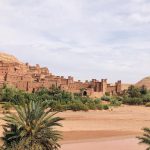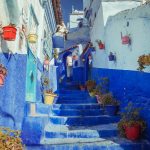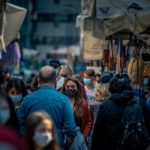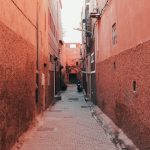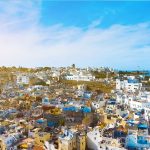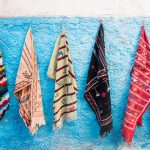Things to Do & See in Fez – Fes
When the most imperial of all Morocco’s cities welcomes its guests, it is to have them experience an altogether unique art of living for themselves. Fez, a melting pot of so many succeeding cultures, has absorbed the very best from each, inheriting Arab nobility, Andalusian sophistication, Jewish ingenuity, and Berber tenacity. Its glorious past, its marvelously preserved material and immaterial heritage, and the timeless aristocracy that lies at the center of its being are all part and parcel of the fascination that the city hold for all those who visit it today.
Today, Fes is one of the most authentic cities in Morocco, known around the world as a center for traditional artists and artisans. Photographers will have a busy time shooting pictures since there is plenty to capture during your visit. Fez boasts 185 mosques, numerous madrasas, and a selection of truly magnificent palaces. There are so many sights that must simply not to be left unseen.
Here are the best things to do and see on your trip to this fascinating city.
1. Take in the smells of the Tanneries:
Follow your nose to the Tanners Quarter. One of the ultimate olfactory medina experiences of medieval Morocco and the most interesting things to do in Fez. This is the most iconic place in Fez, the oldest tannery in the world, and the largest of the traditional tanneries in Fez’s leather souk. Nothing less than a giant artist’s palette.
Chaouwara Tannery dates back to medieval times. Here men make leather in a massive tannery surrounded by houses and shops. The smell of ammonia and rawhide can be overwhelming, but the sight of the multi-colored dyeing vats in the central courtyard is not to be missed. Enter the leather shops built into the surrounding walls for a bird’s-eye view of the action (best in the morning when the vats are still filled with dye). the smell is quite strong, take a bit of mint or a scarf with you.
2. Get lost in the Fes Medina
Fez El Bali (Old Fez) is a warren of twisting lanes and centuries-old monuments and mosques. As well preserved as the traditional architecture are the traditional crafts. This is the city’s oldest neighborhood and UNESCO World Heritage Site. It’s unique in that it has retained much of its history and roots. Vibrant souks ooze with exotic old-world atmosphere, the heady aromas of local cuisine and at times, an overwhelming intensity. Make sure DO NOT experience this at night, that wouldn’t the most comfortable place to get lost unless you are accompanied by a local guide.
3. Bab Bou Jeloud and its green and blue ceramics
If you’ve been to Fes, Morocco, you’ll immediately recognize the Grande Porte Bab Boujeloud, also known as “The Blue Gate of Fes.” If you exit through the Bab Boujloud, however, you’ll note that its other side is actually green. This iconic gate to the Old Medina makes for amazing photos with its unique tiles. The Bab Bou Jeloud and also the Bab Chorfa gates have significant importance and meaning to the history of the city as do the fortresses and towers that once protected the city. When you stroll beneath the famous blue gate of Bab Boujeloud, you are seemingly transported 1,000 years back in time.
4. Visit the oldest university in the World
The University of Al Quaraouiyine is one of Africa’s largest mosques and the oldest existing, continually operating and the first degree-awarding universities in the world. Founded in 859 by Fatima El Fihia and later enlarged, it is the very beating heart of the city. Wandering around Al-Karaouine today, you can admire the institution’s simple yet beautiful design, decorated with Andalusian art bordered with Kufic calligraphy. The university library is home to a number of precious manuscripts including historic copies of the Quran.
5. Take in the History of The Medresas
The Medersas (Koranic universities) bear living witness to the city’s intellectual and scientific past. They are the work of the Merinid sultans and played a prominent part in political, educational, and cultural life. Founded in the 13th century, the first to be built was the Seffarine Medersa, outstanding for the restrained elegance of its decor. Mederasa Bou Inania was built by Sultan Bou Inan in the 14th century but has been beautifully restored, featuring gorgeous mosaics, carved plaster, and impressively large doors. Unlike many such schools, the Bou Inania has a full mosque adjoining it. (For this reason, it’s closed to visitors during prayer times.). The mosque’s beautiful green-tiled, the minaret is the one that’s visible when you enter the medina via Bab Bou Jeloud.The EL-Attarine Medersa was built in 1325, a true masterpiece. The Cherratine Medersa was built by Sultan Moulay Rachid in the 17th century, and could accommodate up to two hundred students at a time.
6. Discover Military History at Borj Nord
This fortress, located above Fez el-Bali was built in the 16th century by Sultan Ahmad al-Mansur to monitor his disloyal population. There are more than 5,000 weapons on display, spanning a range of time periods. In 2016 it opened as an arms museum with an amazing collection of impressive artifacts such as ornate Arab daggers decorated with precious stones and jewels as well as exhibits on military history and traditions of Morocco.
Borj Nord Fortress is also a great place for incredible views of the Old Medina from the roof.
7. Enjoy the art at the Dar BATHA Museum
The Batha palace is now a Museum of Arts and Traditions, conserving rich collections of traditional Fassi artwork, including jewelry, embroidery, carpets, pottery, copperware, and wrought iron. The centerpiece exhibit of the museum is the ceramics room, where the famous Fes blue ceramics, colored with cobalt, are featured. More interesting than the displays themselves are the building’s own original decoration and the lovely internal courtyard garden, which is full of shady trees and tall palms and is a true oasis within the city.
8. Escape to Jardin Jnan Sbil
Need a break from the heat and intensity of the medina, head to Jnan Sbil just outside the medina walls. Jnan Sbil is one of the oldest and most beautiful gardens in Fez. Donated to the public by Sultan Moulay Hassan in The 19th century, it is now a haven of peace and tranquility and the perfect antidote to the sometimes claustrophobic chaos of the medina itself. There are also several cafes near the entrance if you want a relaxed al fresco meal.
9. Dar el Makhzen – The Royal Palace
The most imposing of all Fez Jdid’s monuments is undoubtedly the Royal Palace, which began construction in the 13th century. It might not be open to the public but is definitely worth seeing. Truly an impressive sight, it features gigantic doors made of brass and gold, surrounded by zellij tile work and carved cedarwood. It’s a popular place with tourists, as the detailed mosaics and bold colors make for beautiful pictures that play with light and perspective.
10. See the city from Mount ZALAGH
If you’re a fan of views, this will definitely be worth the hike. a world away from the hustle and bustle of one of the most densely populated areas in Morocco, Mount Zalagh, covered with olive groves and scented by wild lavender, offers a view of the entire city and the surrounding landscapes—the Sebou Valley, Rif Mountains, and Sais Plain. From there you’ll be able to see the whole of Old Medina Fez, as well as views of the surrounding area.
11. Take a Cooking Class
Fassi gastronomy combines sweet with savory, treating fruits as vegetables and making cunning use of a whole range of spices and condiments. The real highpoint of Fassi cuisine, however, is Mrouzia “ a dish originally prepared especially for Aid-el-Adha”.So if you are visiting Fez make sure to do a Moroccan cooking class. Go with a local chef on a shopping tour of the medina to pick out fresh ingredients and spices you will need to prepare authentic Fassi cuisine. A cooking class tour will give you firsthand experience in preparing Moroccan cuisine and understanding Moroccan spices and flavors. See our Morocco Cooking class in Fes
12. Shopping in the Fez Souks
While you wander through the medina of Fez, it’s impossible not to be distracted by the countless shops as far as the eye can see. Colorful plush rugs, handwoven blankets, leather bags of every shape and size, fragrant spices – you’ll need an extra suitcase just to get everything home! Moroccan shopping is much more than souvenir shopping for holiday trinkets – it’s the real deal.
Leather : The leather in Morocco is highly unique and tanned in a medieval way that hasn’t changed in centuries. As you may know, the most famous tannery is the Chouara Tannery of Fez. It’s hard to find the real leather that will withstand the heat.
Rugs: Rugs are another big-ticket purchase for visitors to Morocco. In many shops, you can see the rugs being woven by traditional methods so you know they are handmade in Morocco.
Pottery is truly magnificent with diverse traditional and modern colors and designs influenced by Berber and Islamic art and before them, absorbing Phoenician, Roman, and Byzantine designs. And Even lanterns, slippers, zellige tiles, spices, and Argan oil are all great purchases to make in Morocco. In Fez, you’ll find an abundance of original and handmade products for sale in the medina.
Moroccan carpets: Fes is definitely the home of the Moroccan carpets. While in Medina, be sure to check out one of the carpet shops where they’ll tell you everything you need to know. Just keep in mind that it is high-pressure sales!
13. Trek Through the Tazekka National Park
This national park is roughly an hour and half from Fes and is home to cork oaks and cedars. The Tazekka National Park is one of the great parks in Morocco. It was created in 1950 with only 580 hectares of land in order to protect the many natural resources that could be found at Jbel Tazekka in the Middle Atlas mountain range. It has varied terrain offering habitats to a wide range of reptiles, amphibians, birds, and mammals including the rare Barbary deer (Cervus elaphus barbarous). Also known as the Atlas deer, the Barbary deer was once extinct in Morocco.
14. Fez Medina Guided Tour
You can arrange for a guide to take you through the Medina to ensure you see all the highlights and don’t get lost, however, a quality half or full-day tour of the Fez Medina can make an excellent introduction to places you would probably never find or gain entry to on your own. I’m sure you’ll see the fabulous Fez as only a true local can know. BUT if you do decide to hire a guide; beware of the false guides lingering in the medina offering tours. Or the helpful folk who insist you are lost or offer to show you the way to a particular site. Just be forceful and keep walking away; eventually, they give up and target the next tourist. See our Medina Fes Guided Tour
15. Taking a Hammam
Fes is one of the best places to enjoy the traditional Moroccan path.this will make you feel relaxed and better. there is nothing like scrubbing yourself clean. There are several local hammams (or “public baths”) if you are interested in a local experience. You can ask the staff at your lodgings for the closest local hammam and they will happily show it to you and tell you the hours, they vary by location. You will need to bring your own soap, towel, scrub brush and other amenities. Most riads offer a more upscale experience with private and couples spa and massage. Visiting one the Moroccan Hammam is a delightful experience.

